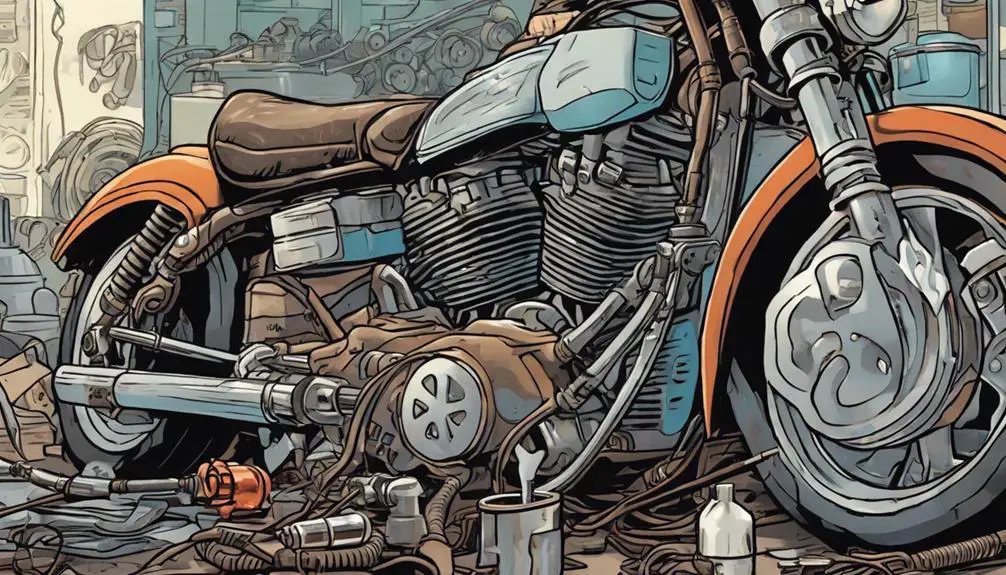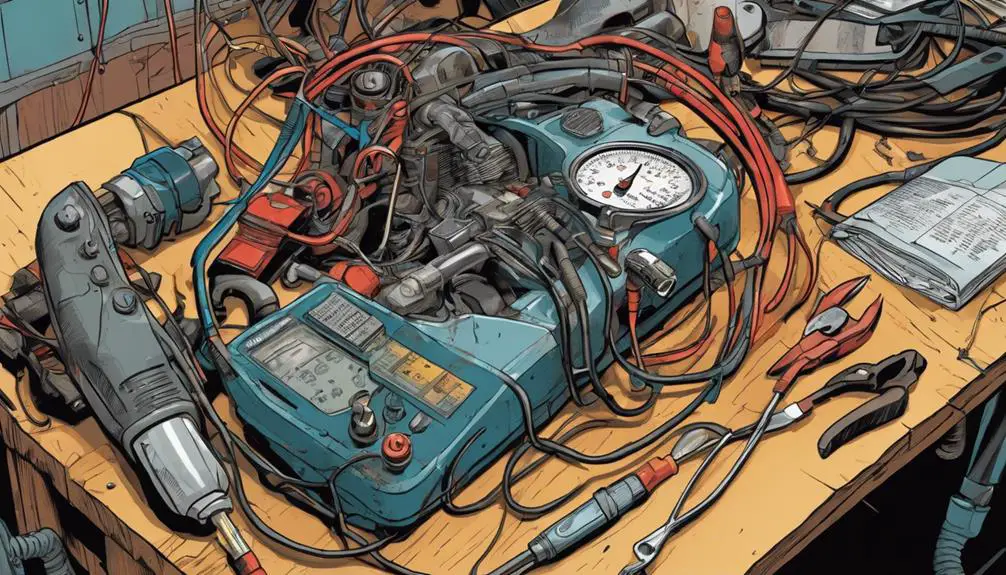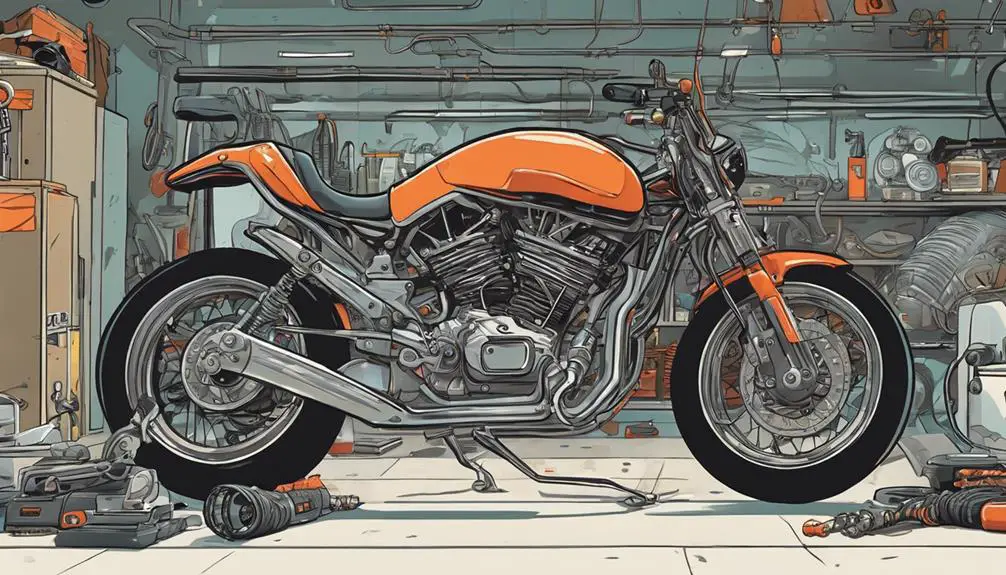Is it true that most motorcycle performance issues stem from neglecting basic maintenance? While many riders might ignore this, understanding the root causes can make all the difference. You might think your bike's problems are complex, but often, simple adjustments or checks can lead to significant improvements. By exploring practical strategies, you'll not only enhance your ride's performance but also extend its lifespan. Curious about what steps you can take to get your motorcycle running smoothly again?
Key Takeaways
- Regularly inspect and replace the air filter to ensure optimal airflow and prevent power loss.
- Clean fuel injectors and replace the fuel filter to maintain consistent fuel flow and engine performance.
- Monitor and adjust tire pressure to enhance handling, safety, and overall riding experience.
- Tune the engine's air-fuel mixture and check spark plugs to prevent misfires and improve throttle response.
Understanding Common Performance Problems

Many riders encounter performance issues that can stem from various mechanical or environmental factors. You might notice your bike sluggish during acceleration, or perhaps it's not idling as smoothly as it used to. These performance problems often signal underlying issues that need attention.
For example, a clogged air filter can restrict airflow, reducing power and efficiency. If you find yourself struggling to maintain speed, check your fuel system; dirty injectors can disrupt the flow and impact performance.
Environmental factors can also play a role. Changes in altitude or temperature can affect your bike's engine performance. If you're riding in higher elevations, your engine mightn't get enough oxygen, leading to a loss of power. Similarly, humidity can alter how your motorcycle performs, especially if it's not calibrated for such conditions.
Listen to your bike. If it's sputtering, shaking, or making unusual noises, it's trying to tell you something. By identifying these common performance problems early, you can take action to liberate your ride from stagnation and guarantee it's ready to take you wherever the road leads.
Regular Maintenance Practices
To keep your motorcycle running smoothly, regular maintenance is key.
Make sure you follow your oil change schedule, check your tire pressure, and inspect your brakes routinely.
These simple practices can greatly enhance your bike's performance and safety on the road.
Oil Change Schedule
Regular oil changes are essential for keeping your motorcycle's engine running smoothly and efficiently. When you prioritize this simple task, you're not just extending your bike's life; you're also enhancing your freedom on the road.
Here's how to stay on track:
- Check Your Manual: Each bike has a recommended oil change interval. Stick to it for peak performance.
- Monitor Mileage: Keep an eye on your odometer. Most motorcycles need an oil change every 3,000 to 5,000 miles.
- Watch for Signs: If your oil looks dark and gritty or if your engine starts to sound rough, it's time for a change, no matter the mileage.
- Set Reminders: Use your smartphone or calendar to remind you when it's time for an oil change. Consistency is key.
Tire Pressure Checks
Keeping an eye on your tire pressure is just as important as sticking to your oil change schedule, as properly inflated tires improve handling and safety on the road.
Under-inflated or over-inflated tires can lead to poor grip, increased wear, and even blowouts, putting you at risk when you're out there enjoying your freedom.
To maintain ideal tire pressure, check it at least once a month and before long rides. Use a reliable tire pressure gauge, and always measure when the tires are cold for the most accurate reading.
Refer to your motorcycle's manual for the recommended pressure levels, as they can vary by model.
If you discover that your tires are low, top them off with air immediately. It's a simple task that can make a huge difference in your ride quality and safety.
Keep in mind that temperature changes can also affect tire pressure, so adjust accordingly with the seasons.
Brake Inspection Routine
A thorough brake inspection is essential for guaranteeing your safety and performance on the road.
You deserve the freedom to ride without worry, and regular brake checks are a key part of that. Here's a quick checklist to get you started:
- Inspect Brake Pads: Look for wear and tear. If they're less than 1/8 inch thick, it's time to replace them.
- Check Brake Fluid: Verify it's at the right level and looks clean. Contaminated fluid can compromise your braking power.
- Examine Brake Lines: Look for cracks or leaks in the hoses. Any damage can lead to brake failure.
- Test Brake Functionality: Before hitting the road, squeeze the brake lever. It should feel firm and responsive.
Optimizing Fuel Quality

To get the most out of your motorcycle, you need to pay attention to fuel quality.
Choosing high-octane fuel can enhance performance, while regular fuel system maintenance helps keep your engine running smoothly.
Choose High-Octane Fuel
Choosing high-octane fuel can greatly enhance your motorcycle's performance and efficiency. By opting for premium fuel, you're not just filling your tank; you're fueling your passion for freedom on the open road. High-octane fuel helps prevent knocking, allows for smoother acceleration, and can even improve your bike's overall responsiveness.
Here are four reasons to contemplate high-octane fuel:
- Improved Engine Performance: Higher octane levels can lead to better throttle response and acceleration.
- Enhanced Fuel Efficiency: You may notice better mileage, allowing you to ride longer and explore further.
- Cleaner Engine Operation: High-octane fuels often have better detergents, which can help keep your engine clean.
- Reduced Emissions: Using higher-quality fuel can lower harmful emissions, contributing to a cleaner environment.
Regular Fuel System Maintenance
Regular fuel system maintenance is key to ensuring that the high-octane fuel you choose continues to enhance your motorcycle's performance. To keep that engine roaring, you'll want to regularly inspect and clean your fuel injectors. Dirty injectors can choke your bike's power and efficiency, so a quick cleaning can work wonders to restore your ride's spirit.
Also, don't overlook your fuel filter. Replacing it according to the manufacturer's guidelines is essential; a clogged filter can starve your engine of the fuel it craves. Check for any leaks in the fuel lines, too—those can lead to performance drops and safety hazards.
Using quality fuel is important, but it's just the start; regular fuel system maintenance is your path to freedom on the road. By staying proactive, you'll release the full potential of your machine.
And remember, every ride should be an exhilarating experience, free from the worries of performance issues. So, take charge—stay on top of your bike's fuel system, and enjoy every twist and turn with confidence. Your motorcycle deserves it, and so do you!
Tuning the Engine Properly
Proper engine tuning transforms your motorcycle's performance, guaranteeing it runs smoothly and efficiently. By fine-tuning your engine, you release the full potential of your ride, giving you that exhilarating freedom you crave.
Here are four key aspects to focus on for peak engine tuning:
- Adjust the Air-Fuel Mixture: Verify you've got the right balance. A lean or rich mixture can hinder performance and efficiency.
- Synchronize Carburetors (if applicable): If your bike has multiple carburetors, synchronizing them can greatly improve throttle response and overall engine performance.
- Check and Replace Spark Plugs: Worn or fouled spark plugs can cause misfires and poor performance. Regularly inspect and replace them as needed to keep your engine firing on all cylinders.
- Tune the Timing: Ignition timing affects power delivery. Adjusting it properly can lead to smoother acceleration and improved throttle response.
Embrace the journey of tuning and let your motorcycle become an extension of your spirit. With proper tuning, you'll feel the difference in every ride, as your bike dances effortlessly on the open road.
Inspecting Electrical Systems

After tuning the engine, it's time to confirm your motorcycle's electrical systems are in top shape, as they play an essential role in overall performance and reliability.
Start by checking the battery; verify it's fully charged and connections are tight. Loose cables can lead to frustrating stalls or poor ignition. If your battery's old, consider replacing it to avoid getting stranded.
Next, inspect the wiring for any frays or corrosion. Damaged wires can cause shorts, affecting your bike's performance. Don't forget to check fuses; a blown fuse might be the reason your lights or signals aren't working.
Pay attention to the charging system as well. Test the voltage output while the bike's running—ideally, it should be between 13.5 to 14.5 volts. If it's outside this range, you might need to look at the stator or regulator.
Lastly, assess your lights and indicators. Proper visibility isn't just about style; it's essential for your safety on the road. Keeping these electrical systems in check guarantees your ride remains smooth, powerful, and liberating.
After all, nothing feels better than the freedom of the open road!
Evaluating Tire Condition
Checking your tire condition is essential for both safety and performance on your motorcycle. Tires are your only contact with the road, and their condition can make or break your ride. To guarantee you're riding freely and confidently, regularly evaluate your tires using these four key factors:
- Tread Depth: Measure the tread depth with a gauge or coin. If it's below the minimum recommended depth, it's time to replace them.
- Sidewall Condition: Inspect for cracks, bulges, or any visible damage. Any irregularities could lead to blowouts.
- Air Pressure: Use a reliable gauge to check tire pressure. Proper inflation maximizes grip and handling.
- Uneven Wear: Look for patterns of uneven wear on the tread. This might indicate alignment issues or improper inflation, which can affect your stability.
Upgrading Performance Parts

Upgrading performance parts can greatly enhance your motorcycle's handling and acceleration, complementing the safety benefits of well-maintained tires. When you decide to release your ride's full potential, focus on components like the exhaust system, air filter, and suspension.
A high-performance exhaust not only amplifies your bike's sound but also boosts horsepower by improving airflow. Pair that with a high-flow air filter, and you'll notice a significant increase in throttle response.
Next, consider your suspension. Upgrading the fork and shock absorbers can transform your motorcycle's stability, especially during aggressive cornering. It'll help you feel more in control, letting you tackle those winding roads with confidence.
Don't forget about the brakes! High-performance brake pads and rotors can provide better stopping power, essential for spirited riding.
Frequently Asked Questions
How Can Weather Affect Motorcycle Performance?
Weather can seriously impact your motorcycle's performance.
When it's wet, your tires lose grip, making it harder to control your ride.
In colder temperatures, the engine might struggle to warm up, affecting power and fuel efficiency.
Hot weather can lead to overheating, causing a drop in performance.
You've got to stay alert and adjust your riding style to the conditions, ensuring you enjoy your freedom on two wheels safely and efficiently.
What Role Does Riding Style Play in Performance Issues?
Riding style influences performance like a dancer's rhythm shapes a performance.
If you ride aggressively, you might experience more wear and tear, while a smoother style can enhance control and efficiency.
You've got to be mindful of how you throttle, brake, and lean into curves.
Adapting your technique can lead to a more liberating experience, allowing your bike to respond seamlessly to your desires and the open road ahead.
Are There Specific Performance Issues for Different Motorcycle Types?
Absolutely, different motorcycle types face unique performance issues.
For instance, cruisers might struggle with stability at higher speeds, while sport bikes can experience overheating during aggressive riding.
Adventure bikes often deal with weight distribution challenges off-road.
Your riding style and the terrain you tackle can amplify these issues.
Understanding your bike's characteristics helps you optimize its performance, so you're more liberated on the road, whether you're cruising or carving through corners.
How Can I Identify Performance Problems While Riding?
How can you enjoy the freedom of the open road if your bike's not performing right?
As you ride, pay attention to unusual sounds, vibrations, or changes in handling.
If the engine hesitates or the throttle feels unresponsive, it's time to investigate.
Trust your instincts; they're often your best guide.
Regularly check your gauges for warnings, and don't ignore that gut feeling when something feels off.
Your ride deserves the best!
What Are Common Myths About Motorcycle Performance Troubleshooting?
You might think that complex problems need complex solutions, but that's a myth.
Many believe you must be a mechanic to troubleshoot effectively, yet anyone can learn basic checks.
Another common misconception is that performance issues always stem from the engine; often, it's something simple like tire pressure or fuel quality.
Conclusion
By keeping your motorcycle in top shape, you're not just riding; you're dancing with the open road.
Regular maintenance, tuning, and upgrades can turn performance problems into smooth sailing.
Don't let minor issues bog you down—address them head-on!
With a little attention and care, your bike will roar back to life, ready to conquer any journey.
So gear up, stay proactive, and embrace the thrill of the ride!